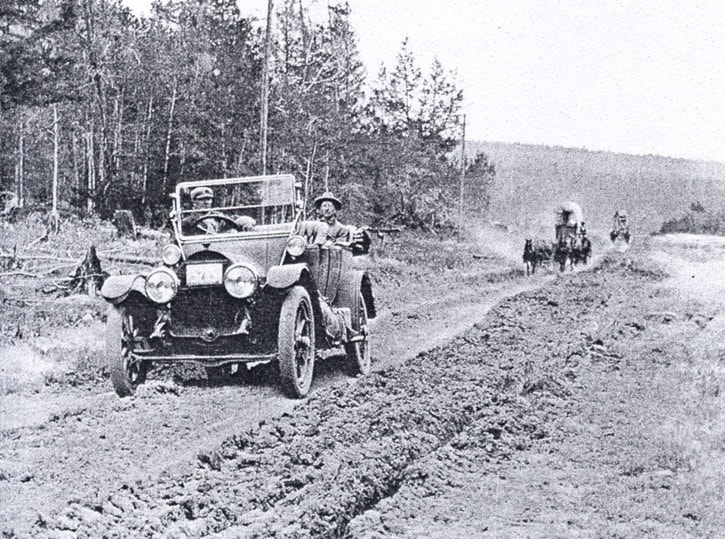By 1910, the B.C. Express Co. had replaced its horse drawn passenger stagecoaches with motorized vehicles which could make the run from Ashcroft to Barkerville with fewer stops and in a faster time.
The main vehicle in use was the Winton touring car, which could easily carry six passengers and, in a pinch, up to nine.
(At that time, all motor vehicles in B.C. drove on the left side of the road, a practice established in the 19th century by the operators of horse drawn vehicles. It was not until New Year’s Day of 1922 at 6 a.m. that B.C. changed over to driving on the right hand side of the road).
On the evening of Aug. 29, 1911, a B.C. Express car returning from Soda Creek, and driver by a man named Frank Inkman, went over the bank on the hill about a mile north of 150 Mile House on the Cariboo Wagon Road.
It was about 9 p.m. and the road was very slippery because of a heavy rainfall.
The vehicle rolled over, and its five occupants were thrown out.
Fortunately, another car happened to come along, and the injured were brought to the 150 Mile Roadhouse.
According to Const. C.B. Palmar of the B.C. Provincial Police, who was stationed at 150 Mile at the time, and who investigated this incident, “the driver was in bad condition and the Chinaman passenger seemed badly hurt. The other passengers had slight injuries.”
The resident doctor at 150 Mile was away, so the nearest other medical practitioner, a retired doctor Mostyn Hoopa, who was living at Soda Creek, was sent for.
The injured were made as comfortable as possible at the roadhouse, but the Chinese fellow died of his injuries at around 2 a.m.
Dr. Hoopa arrived early the next morning at about 7 a.m. He treated the driver and the other injured passengers and, then, a jury was called and an inquest was held into the death of the Chinese man.
The jury quickly reached a verdict (they all had jobs to get to) which exonerated the driver from all blame in the matter, and named the atrocious road conditions as the cause of the accident.
However, they did mention in their verdict about the speed at which some of the cars were driven on this road.
Const. Palmar also wrote: “As the Chinaman seemed to have no friends, I at once took charge of all his effects, and acting on the instructions of the coroner, I have had the body buried.”
The internment was done at the 150 Mile Cemetery in the Chinese section in an unmarked grave.
As far as I can tell, no further effort was made to find the identity of the Chinese man, a sad reflection on the racist attitudes of the times.
This accident must have weighed upon Const. Palmar, for he wrote a letter to the Superintendent of the Provincial Police in Victoria in which he says: “I would like to call your attention to the fact that companies and independent owners of motor cars plying for hire on this road often make the trip from Ashcroft to Soda Creek, 167 miles and back to the 150 Mile House or 141 Mile House, a distance of 200 miles in one day.”
He was concerned that these vehicles leave Ashcroft early in the morning and run for up to 18 or 20 hours in one trip.
He goes on to say: “The point I wish to bring out is that one man cannot sit at a steering wheel of a motor car for such a long time and still be in a proper condition to have the responsibility of the lives of a number of passengers.”
It seems to me that, if one reads between the lines, this first auto fatality could have been the result of driver fatigue.
On a side note, it appears that the road from 150 Mile to Soda Creek was considered to be particularly dangerous.
It contained many sharp turns and had several high embankments and bluffs, and there were heavily wooded areas right down to the roadway itself.
Often animals or deadfall obstructed the right of way, and in bad weather, the road was slippery and treacherous.
In a 1912 letter to the superintendent, Const. W. Spiller of the BC Provincial Police at 150 Mile House asked: “What steps should I take to get a stop watch as I believe there has been considerable trouble here in regard to speeding.”
Apparently, motor cars were making the distance of 29 miles from Soda Creek to 150 Mile House in two hours or less, at the breakneck speed of up to 15 miles per hour!
What would he have thought of the speeds that we travel the same routes today?
Barry Sale is a freelance columnist with the Tribune/Weekend Advisor.
